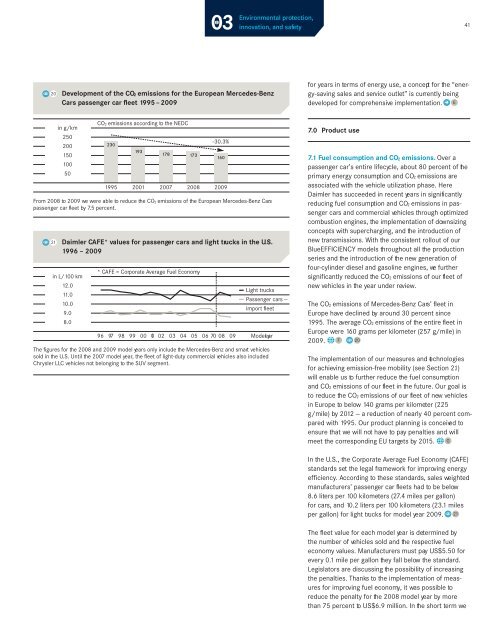Daimler Sustainability Report 2010 - Daimler Sustainability Report ...
Daimler Sustainability Report 2010 - Daimler Sustainability Report ...
Daimler Sustainability Report 2010 - Daimler Sustainability Report ...
You also want an ePaper? Increase the reach of your titles
YUMPU automatically turns print PDFs into web optimized ePapers that Google loves.
� 20 Development of the CO2 emissions for the European Mercedes-Benz<br />
Cars passenger car fleet 1995 – 2009<br />
in g/km<br />
250<br />
200<br />
150<br />
100<br />
50<br />
in L/100 km<br />
12.0<br />
11.0<br />
10.0<br />
9.0<br />
8.0<br />
CO2 emissions according to the NEDC<br />
230<br />
193<br />
178 173<br />
-30.3%<br />
1995 2001 2007 2008 2009<br />
From 2008 to 2009 we were able to reduce the CO2 emissions of the European Mercedes-Benz Cars<br />
passenger car fleet by 7.5 percent.<br />
� 21 <strong>Daimler</strong> CAFE* values for passenger cars and light trucks in the U.S.<br />
1996 – 2009<br />
* CAFE = Corporate Average Fuel Economy<br />
96 97 98 99 00 01 02 03 04 05 06 7 0 08 09 Model ear y<br />
The figures for the 2008 and 2009 model years only include the Mercedes-Benz and smart vehicles<br />
sold in the U.S. Until the 2007 model year, the fleet of light-duty commercial vehicles also included<br />
Chrysler LLC vehicles not belonging to the SUV segment.<br />
160<br />
Environmental protection,<br />
innovation, and safety<br />
Light trucks<br />
Passenger cars —<br />
import fleet<br />
for years in terms of energy use, a concept for the “energy-saving<br />
sales and service outlet” is currently being<br />
developed for comprehensive implementation. D E<br />
7.0 Product use<br />
7.1 Fuel consumption and CO2 emissions. Over a<br />
passenger car’s entire lifecycle, about 80 percent of the<br />
primary energy consumption and CO2 emissions are<br />
associated with the vehicle utilization phase. Here<br />
<strong>Daimler</strong> has succeeded in recent years in significantly<br />
reducing fuel consumption and CO2 emissions in passenger<br />
cars and commercial vehicles through optimized<br />
combustion engines, the implementation of downsizing<br />
concepts with supercharging, and the introduction of<br />
new transmissions. With the consistent rollout of our<br />
BlueEFFICIENCY models throughout all the production<br />
series and the introduction of the new generation of<br />
four-cylinder diesel and gasoline engines, we further<br />
significantly reduced the CO2 emissions of our fleet of<br />
new vehicles in the year under review.<br />
The CO2 emissions of Mercedes-Benz Cars’ fleet in<br />
Europe have declined by around 30 percent since<br />
1995. The average CO2 emissions of the entire fleet in<br />
Europe were 160 grams per kilometer (257 g/mile) in<br />
2009. q F � 20<br />
41<br />
The implementation of our measures and technologies<br />
for achieving emission-free mobility (see Section 2.1)<br />
will enable us to further reduce the fuel consumption<br />
and CO2 emissions of our fleet in the future. Our goal is<br />
to reduce the CO2 emissions of our fleet of new vehicles<br />
in Europe to below 140 grams per kilometer (225<br />
g/mile) by 2012 — a reduction of nearly 40 percent compared<br />
with 1995. Our product planning is conceived to<br />
ensure that we will not have to pay penalties and will<br />
meet the corresponding EU targets by 2015. q G<br />
In the U.S., the Corporate Average Fuel Economy (CAFE)<br />
standards set the legal framework for improving energy<br />
efficiency. According to these standards, sales weighted<br />
manufacturers’ passenger car fleets had to be below<br />
8.6 liters per 100 kilometers (27.4 miles per gallon)<br />
for cars, and 10.2 liters per 100 kilometers (23.1 miles<br />
per gallon) for light trucks for model year 2009. � 21<br />
The fleet value for each model year is determined by<br />
the number of vehicles sold and the respective fuel<br />
economy values. Manufacturers must pay US$5.50 for<br />
every 0.1 mile per gallon they fall below the standard.<br />
Legislators are discussing the possibility of increasing<br />
the penalties. Thanks to the implementation of measures<br />
for improving fuel economy, it was possible to<br />
reduce the penalty for the 2008 model year by more<br />
than 75 percent to US$6.9 million. In the short term we



